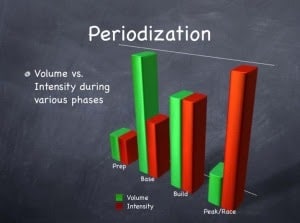
As athletes, we are always striving to be our best. We look at our 5k times, half-marathon times, and Ironman times and are always thinking, how can I improve? How can I get faster? Do I need a new bike? New shoes? And as athletes, some of us want that quick fix. While the quick fix may work for a short period, athletes need to look at their long-term goals while also having some short-term goals in mind.
Many athletes train for a specific event or competition. For example, a triathlete may try to qualify at an Ironman event for the World Championship Ironman in Hawaii, an Olympic lifter may peak to qualify at the Olympic Trials hoping to qualify for the Olympics, and a runner may peak at a marathon trying to qualify for the Boston Marathon. These endurance athletes and strength athletes are doing something called periodization.
Historically, periodization became popular at the time of the ancient Olympics. Athletes have a very simple training logic: They train to compete for pre-Olympics and Olympics and then allow for a little bit of R-n-R. Using this kind of periodized training, athletes plan their whole year around specific events. An athlete’s year can be divided into a prep phase, base phase, build phase, and peak phase.
Leonid Matveyev, a Russian professor, started analyzing how the Soviet athletes trained for the 1952 Olympic Games. His work, which scientifically validated periodization, showed that an annual training plan (ATP) should be divided into phases of training; and each phase should have a specific plan (increase endurance, increase strength, etc.) within that ATP. Each week/phase was then broken down into smaller training phases called “macro-cycle” (2-6 week duration) and “micro-cycle” (one week of training).

Tudor Bompa, a successful coach who emphasized periodization with his athletes, realized that most athletes don’t peak for one event anymore. There are double peak and even triple peak periodizations. When Bompa was coaching rowers and using the mono-cycle, peaking for one event, he realized the athletes were peaking about a month before the World Rowing Championship. This is when Bompa discovered the “bi-cycle” or “double-peak” annual plan.
As a coach, I have seen a lot of athletes picking races left and right and not really having a plan for the triathlon/running season. These athletes will pick 5 or 6 major races for the season, but never consider how to peak specifically for any of the races. For example, one athlete wanted to do a marathon, a 50k run, two Half Ironman, and an Ironman, in the same year. After we chatted this is what we came up with:
What I was seeing is that she wanted to accomplish all of these goals, which she was excited about. I explained that for her to “peak” for a certain event, she needed to spread out her goals throughout a season.
We are training her for a double-peak annual plan in 2020 and a mono-cycle annual plan in 2021. As coaches, we tend to organize an athlete’s training plans by “A, B, C” races. The “A” race is the most important on the schedule, and the training plan is designed around it. Some athletes only want one peak, while others may want 2-3 “A” races. If you have two “A” races, then you need to have one early in the season and try to have the other at the end of the season, when fitness is the highest of the year. “B” races are important since you want to do well at them but you will not “peak” at these races since they are not as critical as the “A” race. “C” races are mostly done for experience, hard workouts, to test your skills and your nutrition, or a tune-up for an “A” race. “C” races should be carefully selected because at “C” races, athletes tend to get injured, tired, or be unmotivated.
Going back to my athlete’s race schedule for 2020 and 2021, this will be the breakdown of her race schedule, after adding some additional races:
Goal setting is a great tool to have when you are training specifically for certain races. As athletes become more competitive, they tend to overtrain AND over-race. As a triathlon coach for over 17 years, I have seen that quite a bit. With just a little bit of guidance, any athlete can ACHIEVE their goals; all you have to do is pick that “A” race for 2020 and 2021!
Looking to learn about the coaching of Rulon Racing Coaches? Click HERE for the link!